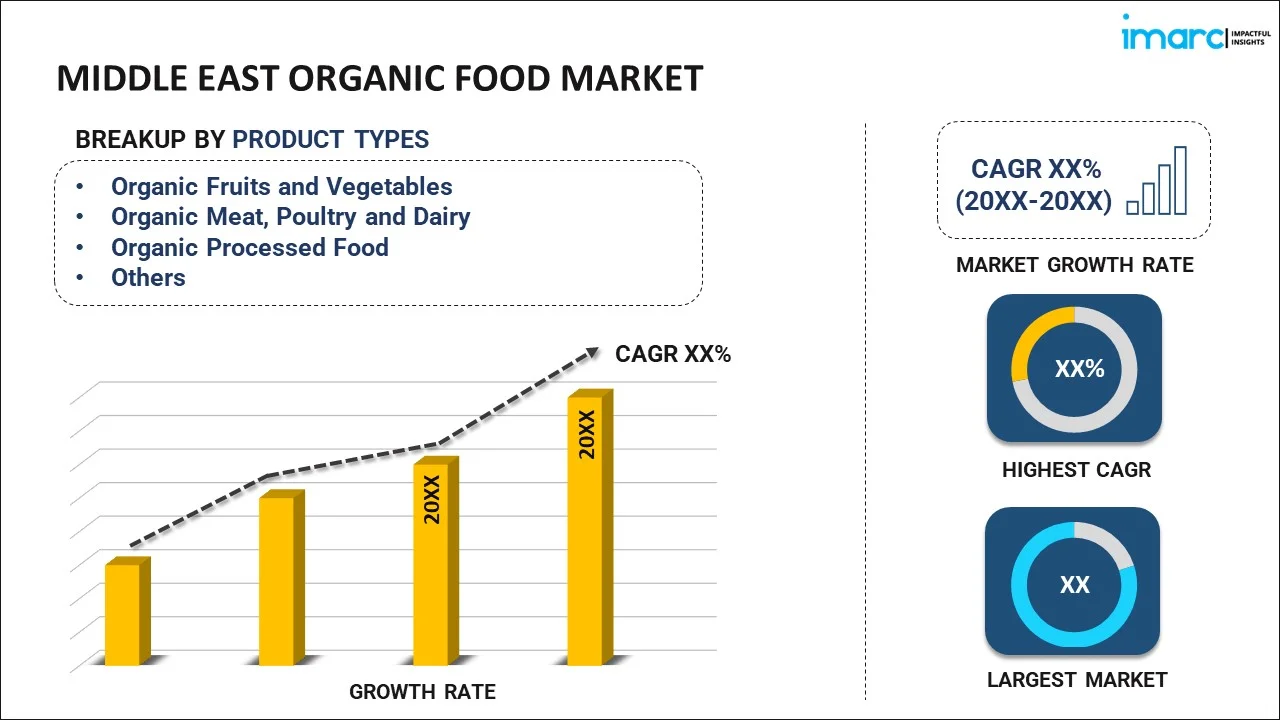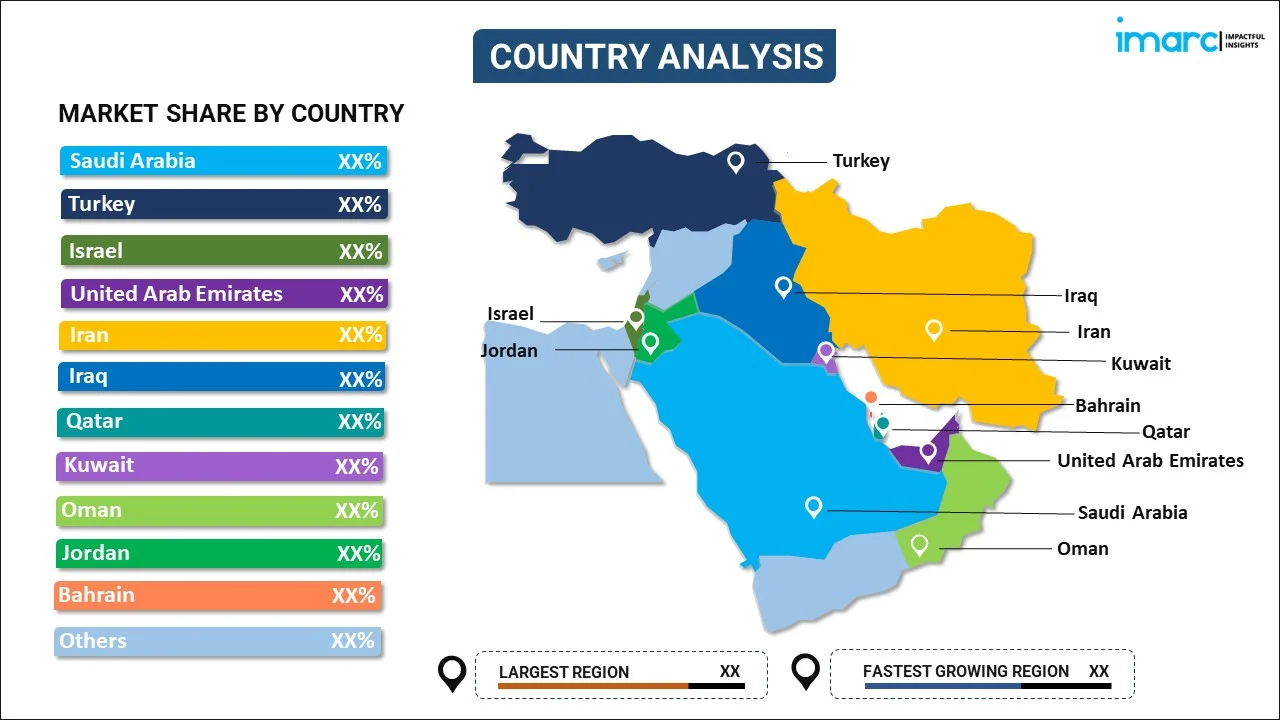IMARC made the whole process easy. Everyone I spoke with via email was polite, easy to deal with, kept their promises regarding delivery timelines and were solutions focused. From my first contact, I was grateful for the professionalism shown by the whole IMARC team. I recommend IMARC to all that need timely, affordable information and advice. My experience with IMARC was excellent and I can not fault it.
Read More
Middle East Organic Food Market Report by Product Type (Organic Fruits and Vegetables, Organic Meat, Poultry and Dairy, Organic Processed Food, Organic Bread and Bakery, Organic Beverages, Organic Cereal and Food Grains, and Others), Distribution Channel (Supermarkets and Hypermarkets, Specialty Stores, Convenience Stores, Online Stores, and Others), Application (Bakery and Confectionery, Ready-to-eat Food Products, Breakfast Cereals, and Others), and Country 2024-2032
Market Overview:
Middle East organic food market size is projected to exhibit a growth rate (CAGR) of 5.50% during 2024-2032. The escalating demand for nutrient-rich and naturally sourced products due to their various health benefits is primarily driving the market growth.
|
Report Attribute
|
Key Statistics
|
|---|---|
|
Base Year
|
2023 |
|
Forecast Years
|
2024-2032
|
|
Historical Years
|
2018-2023
|
| Market Growth Rate (2024-2032) | 5.50% |
Organic food pertains to items cultivated using certified organic ingredients, eschewing the use of synthetic substances such as pesticides, animal feed additives, fertilizers, and genetically modified organisms (GMOs). Various categories of organic food are prevalent, encompassing meat, fruits, vegetables, cereal, beverages, food grains, spices, processed food, dairy products, and pulses. Notably, organic food stands out as a nutritious source of protein, vitamins, antioxidants, and minerals, contributing to improved heart health, strengthened immune function, heightened nutrient intake, and sustained energy levels. In comparison to conventional food, organic alternatives are perceived as healthier, fresher, more natural, and sustainable, aligning with principles of environmental protection. The cultivation and production practices involved in organic farming underscore a commitment to sustainable agriculture, promoting a holistic approach that prioritizes health benefits while minimizing environmental impact.Top of Form
Middle East Organic Food Market Trends:
The Middle East organic food market represents a growing paradigm shift in the region's culinary landscape, with a discernible focus on health and sustainability. This market is characterized by a diverse array of products, ranging from organic fruits and vegetables to meat, cereals, beverages, and dairy items. Besides this, rooted in the principles of certified organic farming, these products are cultivated without the use of synthetic substances like pesticides, fertilizers, and GMOs, aligning with the region's increasing emphasis on natural and sustainable practices. Moreover, organic food, widely recognized for its nutritional richness, provides a source of essential proteins, vitamins, antioxidants, and minerals, contributing to improved well-being. Beyond its health benefits, the Middle East organic food market reflects a broader commitment to environmental stewardship, as organic farming practices prioritize sustainability and ecological balance. Consumers in the Middle East are increasingly drawn to organic alternatives, perceiving them as healthier and fresher choices that resonate with a contemporary awareness of dietary impact on overall health. The market's expansion into various categories of organic products underscores a growing demand for sustainable and ethically produced food options in the region, reflecting a harmonious blend of health-conscious consumer choices and eco-friendly agricultural practices, over the forecasted period.Top of Form
Middle East Organic Food Market Segmentation:
IMARC Group provides an analysis of the key trends in each segment of the market, along with forecasts at the regional and country levels for 2024-2032. Our report has categorized the market based on product type, distribution channel, and application.
Product Type Insights:

- Organic Fruits and Vegetables
- Organic Meat, Poultry and Dairy
- Organic Processed Food
- Organic Bread and Bakery
- Organic Beverages
- Organic Cereal and Food Grains
- Others
The report has provided a detailed breakup and analysis of the market based on the product type. This includes organic fruits and vegetables, organic meat, poultry and dairy, organic processed food, organic bread and bakery, organic beverages, organic cereal and food grains, and others.
Distribution Channel Insights:
- Supermarkets and Hypermarkets
- Specialty Stores
- Convenience Stores
- Online Stores
- Others
A detailed breakup and analysis of the market based on the distribution channel have also been provided in the report. This includes supermarkets and hypermarkets, specialty stores, convenience stores, online stores, and others.
Application Insights:
- Bakery and Confectionery
- Ready-to-eat Food Products
- Breakfast Cereals
- Others
The report has provided a detailed breakup and analysis of the market based on the application. This includes bakery and confectionery, ready-to-eat food products, breakfast cereals, and others.
Country Insights:

- Saudi Arabia
- Turkey
- Israel
- United Arab Emirates
- Iran
- Iraq
- Qatar
- Kuwait
- Oman
- Jordan
- Bahrain
- Others
The report has also provided a comprehensive analysis of all the major regional markets, which include Saudi Arabia, Turkey, Israel, United Arab Emirates, Iran, Iraq, Qatar, Kuwait, Oman, Jordan, Bahrain, and Others.
Competitive Landscape:
The market research report has also provided a comprehensive analysis of the competitive landscape in the market. Competitive analysis such as market structure, key player positioning, top winning strategies, competitive dashboard, and company evaluation quadrant has been covered in the report. Also, detailed profiles of all major companies have been provided.
Middle East Organic Food Market Report Coverage:
| Report Features | Details |
|---|---|
| Base Year of the Analysis | 2023 |
| Historical Period | 2018-2023 |
| Forecast Period | 2024-2032 |
| Units | US$ Million |
| Scope of the Report | Exploration of Historical and Forecast Trends, Industry Catalysts and Challenges, Segment-Wise Historical and Predictive Market Assessment:
|
| Product Types Covered | Organic Fruits and Vegetables, Organic Meat, Poultry and Dairy, Organic Processed Food, Organic Bread and Bakery, Organic Beverages, Organic Cereal and Food Grains, Others |
| Distribution Channels Covered | Supermarkets and Hypermarkets, Specialty Stores, Convenience Stores, Online Stores, Others |
| Applications Covered | Bakery and Confectionery, Ready-to-eat Food Products, Breakfast Cereals, Others |
| Countries Covered | Saudi Arabia, Turkey, Israel, United Arab Emirates, Iran, Iraq, Qatar, Kuwait, Oman, Jordan, Bahrain, Others |
| Customization Scope | 10% Free Customization |
| Report Price and Purchase Option | Single User License: US$ 3699 Five User License: US$ 4699 Corporate License: US$ 5699 |
| Post-Sale Analyst Support | 10-12 Weeks |
| Delivery Format | PDF and Excel through Email (We can also provide the editable version of the report in PPT/Word format on special request) |
Key Questions Answered in This Report:
- How has the Middle East organic food market performed so far and how will it perform in the coming years?
- What has been the impact of COVID-19 on the Middle East organic food market?
- What is the breakup of the Middle East organic food market on the basis of product type?
- What is the breakup of the Middle East organic food market on the basis of distribution channel?
- What is the breakup of the Middle East organic food market on the basis of application?
- What are the various stages in the value chain of the Middle East organic food market?
- What are the key driving factors and challenges in the Middle East organic food?
- What is the structure of the Middle East organic food market and who are the key players?
- What is the degree of competition in the Middle East organic food market?
Key Benefits for Stakeholders:
- IMARC’s industry report offers a comprehensive quantitative analysis of various market segments, historical and current market trends, market forecasts, and dynamics of the Middle East organic food market from 2018-2032.
- The research report provides the latest information on the market drivers, challenges, and opportunities in the Middle East organic food market.
- Porter's five forces analysis assist stakeholders in assessing the impact of new entrants, competitive rivalry, supplier power, buyer power, and the threat of substitution. It helps stakeholders to analyze the level of competition within the Middle East organic food industry and its attractiveness.
- Competitive landscape allows stakeholders to understand their competitive environment and provides an insight into the current positions of key players in the market.
Need more help?
- Speak to our experienced analysts for insights on the current market scenarios.
- Include additional segments and countries to customize the report as per your requirement.
- Gain an unparalleled competitive advantage in your domain by understanding how to utilize the report and positively impacting your operations and revenue.
- For further assistance, please connect with our analysts.

Purchase Options
Benefits of Customization
Personalize this research
Triangulate with your data
Get data as per your format and definition
Gain a deeper dive into a specific application, geography, customer, or competitor
Any level of personalization
Get in Touch With Us
UNITED STATES
Phone: +1-631-791-1145
INDIA
Phone: +91-120-433-0800
UNITED KINGDOM
Phone: +44-753-714-6104
Email: sales@imarcgroup.com
 Inquire Before Buying
Inquire Before Buying Speak to an Analyst
Speak to an Analyst  Request Brochure
Request Brochure  Request Customization
Request Customization



.webp)




.webp)












